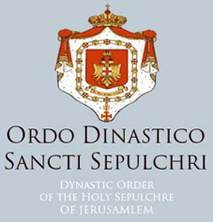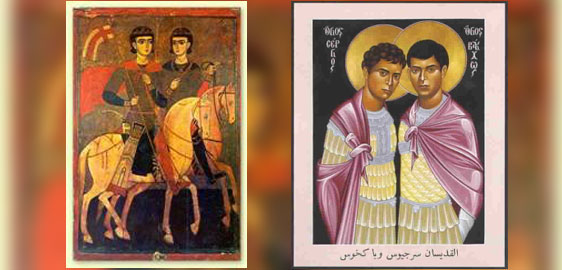


Saint Sergius and Saint Bacchus
Introduction:
Martyrs, d. in the Diocletian persecution in Coele-Syria about 303. Their martyrdom is well authenticated by the earliest martyrologies and by the early veneration paid them, as well as by such historians as Theodoret. They were officers of troops on the frontier, Sergius being primicerius, and Bacchus secundarius. According to the legend, there were high in esteem of the Caesar Maximianus on account of their bravery, but this favour was turned into hate when they acknowledged their Christian faith. When examined under torture they were beaten so severely with thongs that Bacchus died under the blows. Sergius, though, had much more suffering to endure; among other tortures, as the legend relates, he had to run eighteen miles in shoes which were covered on the soles with sharp-pointed nails that pierced through the foot. He was finally beheaded. The burial-place of Sergius and Bacchus was pointed out in the city of Resaph; in honour of Sergius the Emperor Justinian also built churches in honour of Sergius at Constantinople and Acre; the one at Constantinople, now a mosque, is a great work of Byzantine art. In the East, Sergius and Bacchus were universally honoured. Since the seventh century they have a celebrated church in Rome. Christian art represents the two saints as soldiers in military garb with branches of palm in their hands. Their feast is observed on 7 October. According to the "Martyrologium Romanum" they suffered martyrdom soon after the deaths of Sts. Peter and Paul and were buried near Rome. Their existing Acts are not genuine and agree to a great extent with those of Sts. Nereus and Achilleus. The veneration of the two saints is very old. A mass is assigned to them in the "Sacramentarium" of Pope Gelasius.
Historicity:
The Passion, replete with supernatural occurrences and historical anachronisms, has been dismissed as a reliable historical source.[4] There is no firm evidence for Sergius and Bacchus' scholae palatinae having been used by Galerius or any other emperor before Constantine I, and given that persecution of Christians had begun in the army considerably before the overall persecutions of the early 4th century, it is very unlikely that even secret Christians could have risen through the ranks of the imperial bodyguard. Finally, there is no evidence to support the existence of monks, such as the ones said in the Passion to have recovered Bacchus' body, living near the Euphrates during the 4th century.[4]
Instead, the Italian scholar Pio Franchi de Cavalieri has argued that The Passion of Sergius and Bacchus was based on an earlier lost passion of Juventinus and Maximinus, two saints martyred under Emperor Julian the Apostate in 363.[4] He noted especially that the punishment of being paraded around in women's clothes reflected the treatment of Christian soldiers by Julian. David Woods further notes that Zosimus' Historia Nova includes a description of Julian punishing cavalry deserters in just such a manner, further strengthening the argument that the author of The Passion of Sergius and Bacchus took material from the stories of martyrs of Julian's time rather than that of Galerius.[4] Additionally, the work has been dated to mid-5th century, and there is no other evidence for the cult of Sergius and Bacchus before about 425, over a century after they are said to have died. As such there is considerable doubt about their historicity.[4]
Popularity and Veneration:
Veneration of the two saints dates to the 5th century. A shrine to Sergius was built in Resafa around 425, but there is no certain evidence for his or Bacchus' cult much older than that.[4] This shrine was constructed of mudbrick, evidently at the behest of bishop Alexander of Hierapolis. The Passion has been dated to the mid-5th century on the grounds that it describes the construction of such a shrine as if it were a relatively recent occurrence. This structure was replaced with a sturdier stone one in 518; this new site was patronized by important political figures including Roman Emperor Justinian I, King Khosrau II of Sassanid Persia, and Al-Mundhir, ruler of the Ghassanids.[4]
The popularity of the cult of Sergius and Bacchus grew rapidly during the early 5th century, in accordance with the growth of the cult of martyrs, especially military martyrs, during that period.[4]
In the Byzantine Empire, they were venerated as protectors of the army. A large monastery church, the Little Hagia Sophia, was dedicated to them in Constantinople by Justinian I, probably in 527. Sergius was a very popular saint in Syria and Christian Arabia.The city of Resafa, which became a bishop's see, took the name Sergiopolis and preserved his relics in a fortified basilica. Resafa was improved by Emperor Justinian, and became one of the greatest pilgrimage centers in the East. Many other churches were built dedicated in the name of Sergius, sometimes with Bacchus. A church dedicated to Santi Sergio e Bacco was built in Rome in the 9th century. Christian art represents the two saints as soldiers in military garb with branches of palm in their hands. Their feast is observed on 7 October, and a mass is assigned to them in the "Sacramentarium" of Pope Gelasius. The nomads of the desert looked upon Sergius as their special patron saint.
Sergius and Bacchus are noted as a classic example of paired saints; scholar John Boswell considers them to be the most influential example of such a pair, even better an example of such an archetype than Saints Peter and Paul.[5][6] In his book Same-Sex Unions in Premodern Europe, Boswell further argues that Sergius and Bacchus's relationship can be understood as having a romantic dimension, noting that the oldest text of their martyrology describes them as erastai, which can be translated as "lovers".[3] He suggested controversially that the two were even united in a rite known as adelphopoiesis or (brother-making), which he argued was a type of early Christian same-sex union or blessing, reinforcing his view of tolerant early Christian attitudes toward homosexuality.[3] However, Boswell's methodology and conclusions have been critically challenged by historians including David Woods, Robin Darling Young, and Brent Shaw.
